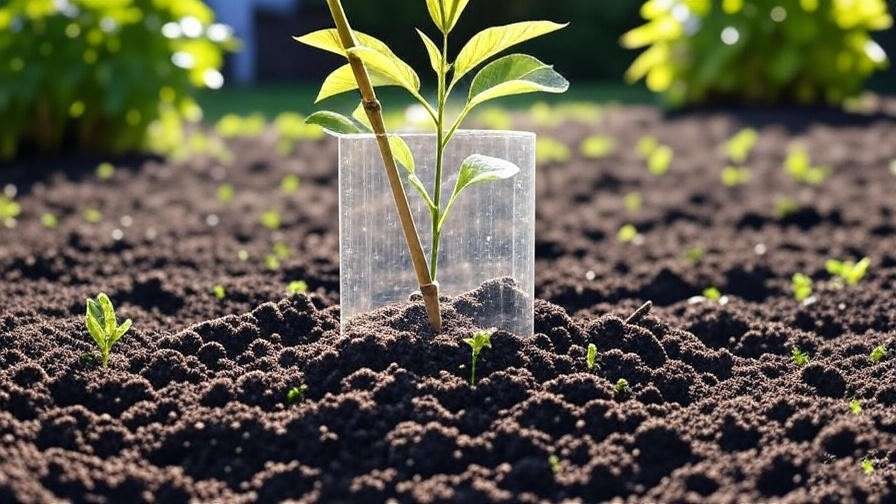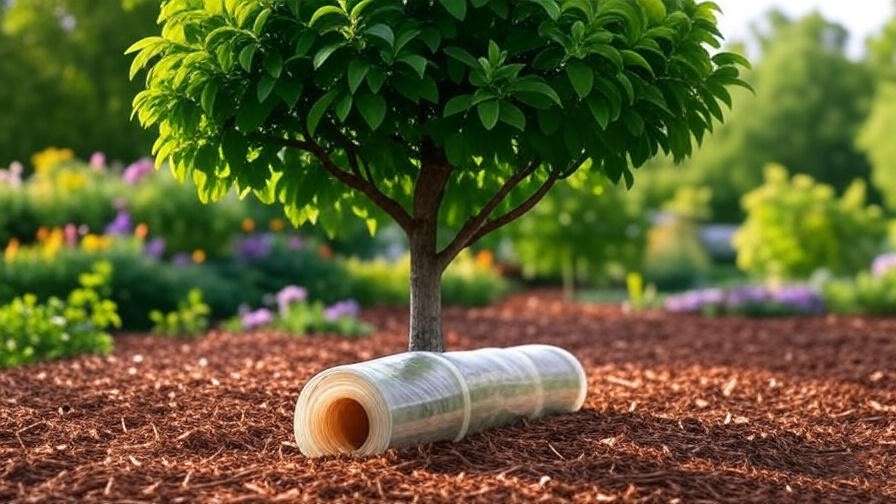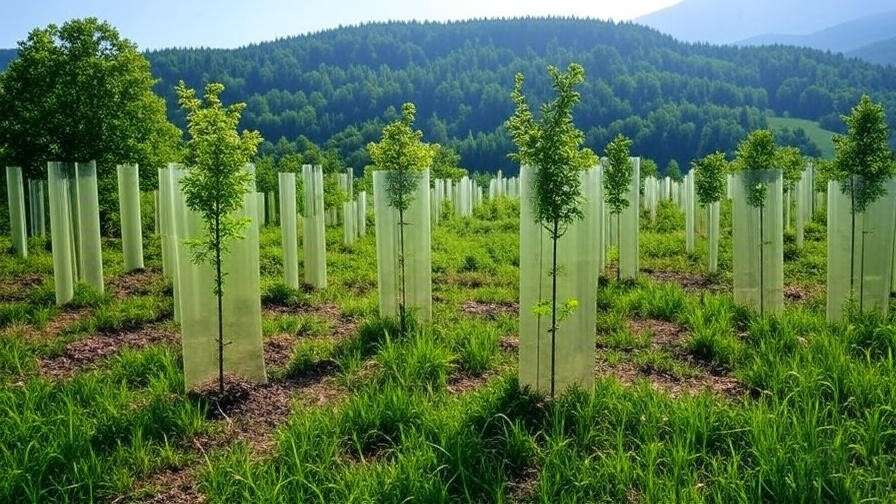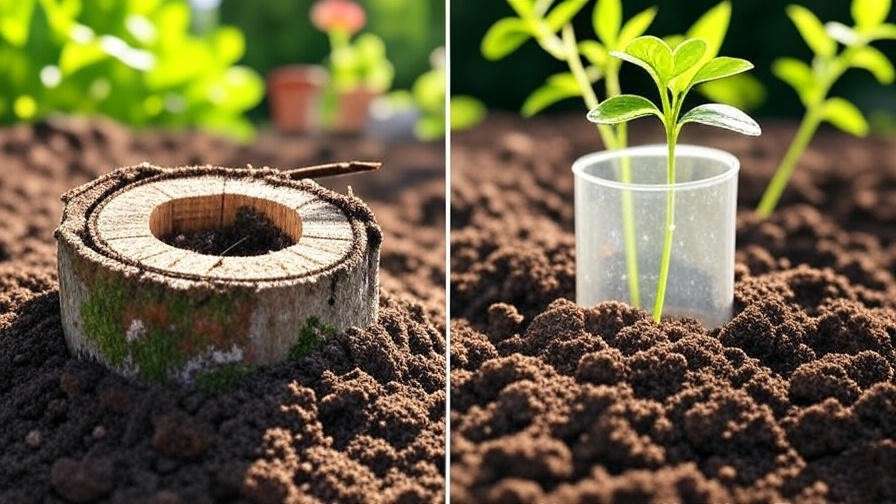Imagine planting a young sapling, only to find it nibbled by deer, scorched by sun, or choked by weeds before it can thrive. Heartbreaking, right? Tree tubes are the game-changing solution every gardener and forester needs to protect young trees and ensure they grow strong and healthy. Whether you’re nurturing a backyard orchard, restoring a forest, or beautifying an urban landscape, tree tubes shield your saplings from harm while boosting their growth. In this comprehensive guide, you’ll discover expert-backed strategies for choosing, installing, and maintaining tree tubes to achieve vibrant, fast-growing trees. Backed by arborist insights and real-world experience, this article will equip you with everything you need to succeed. 🌱
1. What Are Tree Tubes? 🌲
1.1 Definition and Purpose
Tree tubes, also known as tree shelters or tree guards, are protective structures designed to encase young saplings, shielding them from environmental stressors. Typically made of plastic, biodegradable materials, or mesh, these tubes create a safe microclimate for trees, fostering faster growth and higher survival rates. Their primary purposes include protecting trees from herbivores (like deer or rabbits), reducing weed competition, and regulating temperature and moisture. Available in various designs—solid, vented, or biodegradable—tree tubes cater to different climates, tree species, and project goals, making them a versatile tool for tree care.
1.2 Benefits of Using Tree Tubes
Tree tubes offer a multitude of advantages for anyone invested in tree planting:
- Protection from Herbivores: Deer, rabbits, and rodents can devastate young trees by nibbling leaves or stripping bark. Tree tubes act as a physical barrier, keeping animals at bay.
- Enhanced Growth: By creating a greenhouse-like effect, tubes retain moisture and warmth, promoting faster stem and root development.
- Weed Suppression: Tubes block sunlight from reaching the soil around the tree’s base, reducing competition from invasive weeds.
- Versatility: From backyard gardens to large-scale reforestation, tree tubes are essential for ensuring tree survival in diverse settings.
2. Why Use Tree Tubes? 🌿
2.1 Challenges Faced by Young Trees
Young trees face a gauntlet of challenges that can hinder their growth or lead to early death. Herbivores are a primary threat, with deer capable of destroying a sapling in a single night. Harsh weather—scorching sun, freezing winds, or heavy rain—can stress or damage delicate trees. Weeds compete for water, nutrients, and sunlight, stunting growth. Without protection, many saplings fail to reach maturity, wasting time, effort, and resources. Tree tubes address these issues head-on, offering a simple yet effective solution for tree care professionals and hobbyists alike.
2.2 How Tree Tubes Solve These Problems
Tree tubes are a proven tool for overcoming these obstacles:
- Animal Protection: A sturdy tube prevents browsing animals from accessing tender shoots and bark.
- Microclimate Control: Tubes trap heat and moisture, creating ideal conditions for photosynthesis and root establishment, especially in harsh climates.
- Weed Control: By shading the soil, tubes reduce weed growth, allowing trees to access more nutrients and water.
- Case Study: In a Midwest reforestation project, oak saplings protected by tree tubes showed a 90% survival rate compared to 50% for unprotected trees after two years, highlighting their effectiveness.
3. Choosing the Right Tree Tubes 🛠️
3.1 Types of Tree Tubes
Selecting the right tree tube depends on your project’s needs. Here are the main types:
- Plastic Tubes: Durable and reusable, these are ideal for long-term use in orchards or urban settings. They’re cost-effective but may require removal and recycling.
- Biodegradable Tubes: Made from materials like cornstarch or cardboard, these eco-friendly options degrade naturally, perfect for sustainable reforestation projects.
- Vented vs. Solid Tubes: Vented tubes allow airflow, reducing mold in humid climates, while solid tubes offer maximum protection in windy or dry regions.
- Specialty Tubes: UV-resistant or extra-tall tubes cater to specific conditions, such as high-sun exposure or areas with tall herbivores like deer.
3.2 Factors to Consider When Selecting Tree Tubes
To choose the best tree tubes, consider:
- Tree Species: Hardwoods like oak or maple may need taller tubes, while conifers like pine benefit from vented designs.
- Climate: In hot, humid regions, opt for vented tubes to prevent fungal growth. In windy areas, choose sturdy, well-anchored tubes.
- Budget and Scale: Plastic tubes are more affordable for large projects, while biodegradable tubes suit eco-conscious smaller plantings.
- Expert Tip: For deer-heavy areas, select tubes at least 4-5 feet tall to ensure adequate protection.
3.3 Where to Buy Quality Tree Tubes
Purchase tree tubes from reputable suppliers like Wilson Forestry Supply, Treessentials, or A.M. Leonard. Look for high-quality materials, adequate ventilation, and warranties for durability. Prices typically range from $1 to $5 per tube, depending on size and material. For large orders, bulk discounts can reduce costs. Always check customer reviews and ensure the tubes meet your project’s specific needs.
4. How to Install Tree Tubes Properly ⚙️
4.1 Preparing the Site
Proper site preparation sets the stage for successful tree growth:
- Location: Choose a site with 6-8 hours of sunlight daily and well-draining soil. Avoid low-lying areas prone to waterlogging.
- Weed Control: Clear weeds and grass within a 2-foot radius of the planting site to minimize competition.
- Soil Testing: Test soil pH (ideal range: 6.0-7.0) and add amendments like compost or lime if needed.

4.2 Step-by-Step Installation Guide
Follow these steps to install tree tubes correctly:
- Gather Tools: You’ll need a sturdy stake (bamboo or metal), zip ties or twine, a mallet, and the tree tube.
- Plant the Tree: Dig a hole twice the width of the root ball, place the tree, and backfill with soil, ensuring no air pockets.
- Install the Stake: Drive the stake 12-18 inches into the ground, 2-3 inches from the tree’s base, at a slight angle for stability.
- Position the Tube: Slide the tube over the tree, ensuring the base rests on the soil and the top clears the tree’s canopy.
- Secure the Tube: Use zip ties or twine to attach the tube to the stake, ensuring it’s snug but not constricting.
- Check Alignment: Ensure the tube is vertical and not rubbing against the tree.
- Pro Tip: Check the tube monthly to ensure it’s not shifting or constricting the tree as it grows.
4.3 Common Installation Mistakes to Avoid
Avoid these pitfalls to ensure success:
- Tubes Too Tight: A tight tube can damage the tree’s bark or restrict growth. Leave a small gap for air circulation.
- Weak Stakes: Inadequate staking can lead to tube collapse in high winds. Use sturdy materials and drive stakes deep.
- Poor Ventilation: In humid climates, solid tubes can trap moisture, causing mold. Opt for vented tubes or monitor closely.
5. Maintaining Trees with Tree Tubes 🌞
5.1 Monitoring Tree Growth
Regular monitoring is crucial to ensure your tree thrives within its protective tube. Check for signs of stress, such as yellowing leaves, stunted growth, or bark rubbing against the tube’s interior. As the tree grows, ensure the tube remains loose enough to avoid constriction—typically, the trunk should have a 1-2 inch gap from the tube’s inner wall. If the tree’s canopy begins to press against the tube’s top, it may be time to adjust or remove the tube. Expert Insight: Gradually expose the tree to outdoor conditions by partially lifting the tube for a few weeks before full removal to prevent shock.
5.2 Weed and Pest Management
Tree tubes reduce weed competition, but vigilance is still needed:
- Weed Control: Inspect the base of the tube regularly and remove any weeds that sprout inside or around it. Use mulch or a weed barrier fabric outside the tube to further suppress growth.
- Pest Monitoring: Tubes can occasionally trap pests like rodents or insects. Check for signs of chewing, webbing, or insect activity inside the tube. If pests are present, remove them manually or use organic solutions like neem oil.
- Organic Solutions: Introduce beneficial insects, such as ladybugs, to control aphids, or use natural repellents like cayenne pepper for rodents.
5.3 Watering and Fertilizing with Tree Tubes
Proper hydration and nutrition are vital for young trees:
- Watering Needs: Young trees typically need 1-2 gallons of water weekly, depending on climate and soil type. Ensure water reaches the root zone by pouring it directly into the tube or using a drip irrigation system. Avoid overwatering, which can lead to root rot, especially in poorly drained soils.
- Fertilizing: Apply a balanced, slow-release fertilizer (e.g., 10-10-10 NPK) every 4-6 weeks during the growing season. For organic options, use compost tea or fish emulsion to boost soil nutrients.
- Quick Tip: Install a drip irrigation system for large plantings to ensure consistent moisture delivery, especially in dry climates.
6. When and How to Remove Tree Tubes 🕒
6.1 Signs It’s Time to Remove the Tube
Tree tubes are typically temporary, used for 1-3 years depending on the tree’s growth rate and environmental conditions. Remove the tube when:
- The tree’s trunk diameter exceeds the tube’s capacity (usually 1-2 inches in diameter).
- The tree reaches a height where it can withstand herbivores and weather (4-6 feet for most species).
- The canopy is well-developed, indicating the tree is strong enough to thrive without protection.

6.2 Safe Removal Process
To remove a tree tube without harming the tree:
- Choose the Right Time: Remove tubes in spring or fall when temperatures are mild to minimize stress.
- Loosen the Tube: Cut zip ties or twine and gently lift the tube to check for resistance. If the tree is entangled, carefully free any branches.
- Gradual Exposure: If the tree has been in the tube for over a year, lift it partially for 1-2 weeks to acclimate the tree to outdoor conditions.
- Recycle or Reuse: Clean plastic tubes with mild soap and water for reuse. Biodegradable tubes can be left to decompose or composted if intact.
- Pro Tip: Inspect the tree’s bark and branches for any signs of rubbing or damage after removal, and prune lightly if needed.
6.3 Reusing or Recycling Tubes
Plastic tree tubes can be reused for multiple planting seasons if undamaged. Store them in a dry, shaded area to prevent UV degradation. Biodegradable tubes are designed to break down naturally, reducing waste. Check with local recycling programs for options to dispose of plastic tubes responsibly.
7. Tree Tubes for Specific Use Cases 🌍
7.1 Reforestation Projects
Tree tubes are a cornerstone of successful reforestation efforts. By protecting saplings from browsing animals and harsh weather, they significantly increase survival rates. For example, a 2020 study by the University of Minnesota’s Forestry Department found that oak and pine saplings protected by tree tubes had an 85% survival rate after three years, compared to 40% for unprotected trees. Tubes also promote straighter stems, which is valuable for timber production. In large-scale projects, biodegradable tubes are often preferred for their eco-friendly footprint.

7.2 Orchard and Fruit Tree Care
Fruit trees, such as apple, pear, or citrus, benefit immensely from tree tubes:
- Protection: Tubes shield young fruit trees from deer, rabbits, and mechanical damage (e.g., from lawnmowers).
- Growth Boost: The microclimate inside tubes accelerates fruit tree establishment, leading to earlier fruit production.
- Species-Specific Tips: For apple trees, use 4-foot vented tubes to prevent overheating. For citrus, opt for UV-resistant tubes to withstand intense sunlight.
7.3 Urban and Landscaping Applications
In urban environments, tree tubes protect street trees from vandalism, vehicle damage, and pedestrian traffic. They also enhance aesthetics by keeping young trees tidy and uniform. Choose tubes with a neutral color (e.g., green or brown) to blend with city landscapes. For example, municipalities in Portland, Oregon, have used tree tubes to protect newly planted street trees, reporting a 30% increase in survival rates.
8. Troubleshooting Common Issues with Tree Tubes 🐞
8.1 Tube-Related Problems
While tree tubes are highly effective, issues can arise:
- Mold or Mildew: In humid climates, poor ventilation can lead to fungal growth inside tubes. Use vented tubes or drill small holes in solid tubes to improve airflow.
- Tube Collapse: High winds can topple poorly staked tubes. Reinforce stakes with deeper installation or use heavier materials like metal.
- Solution: Regularly inspect tubes and replace damaged ones promptly to maintain protection.

8.2 Tree Health Issues
If a tree shows signs of stress, diagnose the cause:
- Nutrient Deficiencies: Yellowing leaves may indicate a lack of nitrogen or iron. Test soil and apply a citrus-specific fertilizer if needed.
- Overwatering: Soggy soil or root rot suggests excessive watering. Adjust irrigation and ensure proper drainage.
- Pest Damage: Look for chew marks or insect activity. Remove pests manually or apply organic treatments like insecticidal soap.
- Expert Advice: Consult a local arborist if problems persist, as they can provide region-specific solutions.
9. FAQs About Tree Tubes ❓
- How long should tree tubes stay on?
- Most trees need tubes for 1-3 years, depending on growth rate and environmental threats. Remove once the trunk is 1-2 inches thick and the tree is 4-6 feet tall.
- Do tree tubes work for all tree species?
- Tree tubes are compatible with most hardwoods, conifers, and fruit trees, but specific designs (e.g., vented or tall tubes) may be needed for certain species.
- Can tree tubes be reused?
- Plastic tubes can be cleaned and reused for multiple seasons. Store them properly to avoid damage.
- Are tree tubes environmentally friendly?
- Biodegradable tubes are eco-friendly, while plastic tubes require recycling. Choose biodegradable options for sustainable projects.
10. Expert Insights and Pro Tips 🌟
- Arborist Quote: “Tree tubes are like a suit of armor for young trees, giving them the protection they need to thrive in tough conditions,” says Dr. Emily Carter, a forestry expert at Purdue University.
- Advanced Technique: Pair tree tubes with organic mulch (e.g., wood chips) to further suppress weeds and retain soil moisture.
- Sustainable Practice: Opt for biodegradable tubes in reforestation projects to minimize environmental impact, or participate in local tube recycling programs.
11. Conclusion
Tree tubes are an indispensable tool for anyone serious about growing healthy, fast-growing trees. By shielding saplings from herbivores, harsh weather, and weeds, they create the ideal conditions for success in gardens, orchards, and reforestation projects. With the right selection, installation, and maintenance, tree tubes can transform your planting efforts, ensuring vibrant trees for years to come. Start using tree tubes in your next project and watch your saplings thrive! Share your success stories or questions in the comments below—we’d love to hear from you! 🌳













